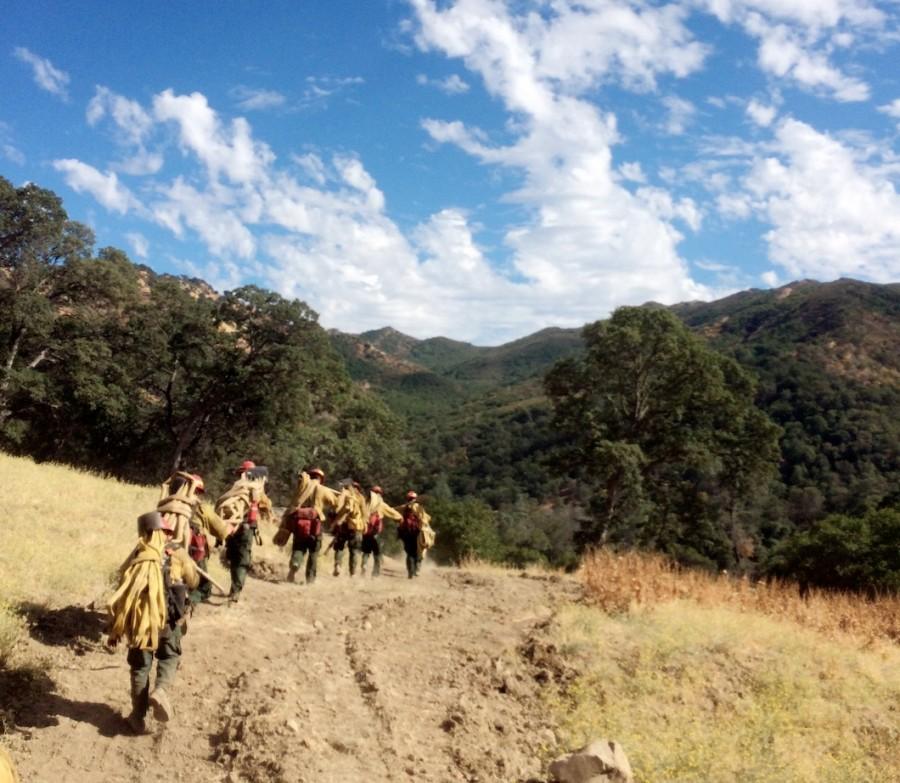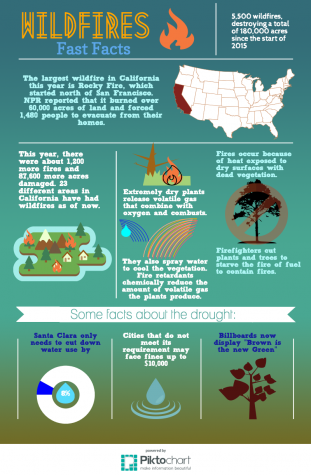Drought spawns wildfires
More than 5,500 California wildfires have ravaged a total of 180,000 acres since the beginning of the year.
The ongoing four-year drought that California is facing, which has been known to induce some of the wildfires, has caused California governor Jerry Brown to declare “a state of emergency.”
“It used to be that there was a big difference between the moisture in the green versus what looks dead, the brown vegetation,” said Margaret Stewart, spokesperson for the LA Fire Department. “Now, the water content is so low in the green vegetation that it’s almost like it’s dead. So, that means fires start and spread more easily.”
Among the largest and most active wildfires in California this summer is the so-called “Rocky Fire.” According to NPR, this wildfire alone has destroyed over 60,000 acres of land in the state and forced 1,480 people from their homes. Originating just north of San Francisco, the fire has outsized the city itself.
Compared to last year, there have been around 1,200 more fires and 87,600 more acres damaged. Some fires have started in the past few weeks due to thousands of lightning strikes in dry areas caused by the drought. So far, 23 different areas in California have had wildfires.
Forest fires often occur because of intense heat applied to arid surfaces such as dead and fallen trees. When exposed to heat, extremely dry plants release explosive gases, which combust into flames while combining with oxygen in the air, according to The New York Times.
To contain the flames, firefighters reduce the amount of fuel by cutting or burning plants and trees. They also spray water to cool the vegetation because it turns into steam while in contact with heat. Fire retardants, an orange-pink substance that is usually released by planes, chemically reduce the amount of volatile gas the plants produce.
Many water limitations and rules have been set across the state in many cities because of the drought situation and scarcity of water. Billboards are often seen displaying the phrase “Brown is the new green” to discourage residents from watering their lawns; some cities have also enforced rules as to how much water can be used.
Because Santa Clara is already conserving water, the government only requires the lowering of water consumption by eight percent. According to the city of San Jose, houses are appointed certain days to water the lawn, depending on their location. In San Jose, washing the driveway and sidewalks with drinkable water, filling up a pool and providing water in restaurants without a request from the customers are considered illegal as a result of the new regulations.
While for some people the drought and water usage are the most important issues, others in wildfire danger zones have to worry about when to evacuate their homes and how to rebuild them after drought-induced fires.
Water limitations as a result of the drought began as early as April when governor Brown demanded a 25 percent decrease in water use by towns and cities in California.
More rules came into effect starting June and are supposed to stay in effect until February 2016. The new rules involve the watering of lawns, washing of cars and other excessive uses of water. Cities that maintain a certain level of water usage will be rewarded for their water conservation, while those that don’t may be faced with fines of up to $10,000.
By March, cities had lowered water usage by an average of 3.6 percent, which did not match Brown’s expectation for the state. In response, he furthered the limitations and cities were required to lower their usage by percentages ranging from eight to 36 percent this past summer.
According to Stewart, the two things that the fire department would suggest to people living in fire hazard zones are to prepare for the possibility of a fire with emergency kits and to evacuate quickly when a fire arrives.
This piece was originally published in the pages of The Winged Post on August 31, 2015.

Trisha Dwivedi (12) is the Managing Editor of Harker Aquila. She was a reporter her freshman year, Business Manager of the Winged Post her sophomore year...

Jackie Gao (10) is in her second year on staff is a reporter of the Winged Post. Her favorite part of journalism is the ability to interact with various...


















![“[Building nerf blasters] became this outlet of creativity for me that hasn't been matched by anything else. The process [of] making a build complete to your desire is such a painstakingly difficult process, but I've had to learn from [the skills needed from] soldering to proper painting. There's so many different options for everything, if you think about it, it exists. The best part is [that] if it doesn't exist, you can build it yourself," Ishaan Parate said.](https://harkeraquila.com/wp-content/uploads/2022/08/DSC_8149-900x604.jpg)




![“When I came into high school, I was ready to be a follower. But DECA was a game changer for me. It helped me overcome my fear of public speaking, and it's played such a major role in who I've become today. To be able to successfully lead a chapter of 150 students, an officer team and be one of the upperclassmen I once really admired is something I'm [really] proud of,” Anvitha Tummala ('21) said.](https://harkeraquila.com/wp-content/uploads/2021/07/Screen-Shot-2021-07-25-at-9.50.05-AM-900x594.png)







![“I think getting up in the morning and having a sense of purpose [is exciting]. I think without a certain amount of drive, life is kind of obsolete and mundane, and I think having that every single day is what makes each day unique and kind of makes life exciting,” Neymika Jain (12) said.](https://harkeraquila.com/wp-content/uploads/2017/06/Screen-Shot-2017-06-03-at-4.54.16-PM.png)








![“My slogan is ‘slow feet, don’t eat, and I’m hungry.’ You need to run fast to get where you are–you aren't going to get those championships if you aren't fast,” Angel Cervantes (12) said. “I want to do well in school on my tests and in track and win championships for my team. I live by that, [and] I can do that anywhere: in the classroom or on the field.”](https://harkeraquila.com/wp-content/uploads/2018/06/DSC5146-900x601.jpg)
![“[Volleyball has] taught me how to fall correctly, and another thing it taught is that you don’t have to be the best at something to be good at it. If you just hit the ball in a smart way, then it still scores points and you’re good at it. You could be a background player and still make a much bigger impact on the team than you would think,” Anya Gert (’20) said.](https://harkeraquila.com/wp-content/uploads/2020/06/AnnaGert_JinTuan_HoHPhotoEdited-600x900.jpeg)

![“I'm not nearly there yet, but [my confidence has] definitely been getting better since I was pretty shy and timid coming into Harker my freshman year. I know that there's a lot of people that are really confident in what they do, and I really admire them. Everyone's so driven and that has really pushed me to kind of try to find my own place in high school and be more confident,” Alyssa Huang (’20) said.](https://harkeraquila.com/wp-content/uploads/2020/06/AlyssaHuang_EmilyChen_HoHPhoto-900x749.jpeg)




